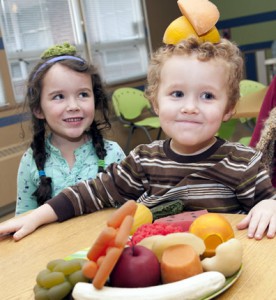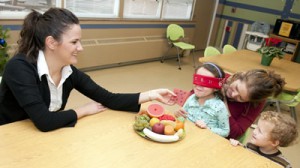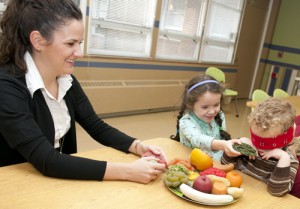“If it were my kid, they’d eat whatever I served; I’m no short-order cook.”
“When I was a child, I either ate my food or had it served cold at breakfast.”
“Picky eaters weren’t allowed in my day.”

Sound familiar?
I’m a mother of two, and I will confess: Before I had my kids, I was the kind of person to say these kinds of things. Feeding children seemed simple; they either ate the food or they didn’t. Case closed.
But now that I have two very opinionated children at my table each night, the case is not only very much open, it’s a daily wrenching drama of wills that has driven all of us to the kind of emotional extremes usually reserved for daytime soaps.
It would be entertaining if it weren’t so frustrating. My son, almost 4, refuses to touch his lips to anything green; my 6-year-old daughter weeps at the sight of any kind of meat on her plate that isn’t a chicken nugget or hot dog.
A Food War on All Fronts
Some of this is typical of little children. Their taste buds haven’t matured, and they prefer routine, plain meals with simple textures and expected flavors.
But we’re also up against a proliferation of sugary, fattening foods marketed to their age group: Candy-flavored yogurt, gummy “fruit” snacks, chocolate bars posing as granola bars, juice jacked up with artificial flavoring. This, when one in three children in America suffer from obesity – which leads to a range of heart problems like high cholesterol, type 2 diabetes and high blood pressure.
And no: You can’t force-feed or starve them. As a parent, you not only want your children to get enough to eat, and to eat enough of the right things, you want their relationship to food (and to you) to be healthy and positive. Forcing children to eat can lead to serious binge behaviors and prevents them from learning self-regulation.
Never fear – the Children’s Fitness Clinic is here. My kids and I met with Angie Hasemann, registered dietitian, to find out what she does to help kids eat better. Hasemann usually works with kids who are obese or suffering from high cholesterol – she’s seen these factors in kids as young as age 3. But her tips and ideas for getting kids to eat healthy meals can apply to any parent facing dinnertime with dread.
Introducing New Foods: Play With Your Food
While Hasemann doesn’t advocate playing games with food or at the dinner table all the time, creativity can be one way to encourage a skeptical kid to try something unfamiliar.

1. Everyone at the table puts their hands behind their back and tries to eat the food in question without using their hands – or using a straw. “Imagine your kids sucking up fiber-filled peas like a vacuum,” Hasemann says.
2. Parents have to try foods they don’t like – and kids play the enforcers. In Hasemann’s experience, “this will likely help kids to then try new foods, too.” One fun idea: Use a blindfold. Often kids gauge the taste of a food based on what it looks like.
3. Paint a rainbow with the food – have kids help you fill the plate with something of each color.
4. Track each family member’s daily intake of fruits and vegetables on a wall chart (possibly to earn a prize). Hasemann’s advice: “Encourage a friendly competition and cheer on each other’s successes.”
5. Food art! Be creative and make a face or build something with the food.
Presenting food preparation and eating as fun can help reduce anxiety and stress for the whole family.

Add a Chef to the Kitchen
Kids are more likely to eat foods they’ve picked out or prepared themselves. Some ways to get them involved:
6. Let your child pick out something new at the grocery store.
7. Have them help make the food. One fun idea is to mash sweet potatoes or a similar type of food in a closed plastic baggie that “can then be added to many dishes as a hidden power punch of vitamin A,” Hasemann suggests. Other jobs children can easily perform:
- Putting food on kabobs
- Shredding cheese
- Stirring
- Shucking corn
- Cutting and spreading soft butter or spreads
- Peeling fruit, such as bananas and oranges
8. Stock the fridge with fresh fruits washed and ready to eat in a bowl right at their eye level.
Great suggestions! I always said those things, too! Now we do our best to have the same meals but might make little changes- a small portion with the spices dialed back a bit (but still some so they can get used to the taste). We also have a rule that if we have something new they have to take two small bites. It’s amazing how the first bite/ taste is always terrible but then the second one is sometimes pretty good! Exposing the kids to new things has worked pretty well; our older daughter is adventurous and is now willing to try just about anything- new veggies, different ethnic foods, etc. Our son who is only six is still a bit of a challenge but getting better. Someday…
I have two semi-picky eaters. What I have learned about my kids is that their sensory systems are just so much more sensitive than mine, as an adult. My son is much more likely to try new foods in the middle of the day when he is neither just waking up nor over stimulated from a busy day. I try to put a couple of staples that I know he’ll eat and a new item or two on the plate. Once he gets used to seeing the new items he is more likely to willingly try them. Like the previous commenter, dialing back flavors a bit has helped us too.
We don’t have a rule about trying everything. I remember only too well gagging on foods like liver and blue cheese (and I still would!). But I will separate out the foods that I’m cooking, because my preschooler will eat all kinds of vegetables if they are separated, rather than mixed together. And when she wants to fill up on one type of food, like shrimp, and asks for more shrimp when there’s other food on her plate, we tell her she has to have some of the other foods, like the collard greens and rice, before she can have seconds on whatever is her favorite part. I am always amazed when this works. I also find it varies day to day – some days she’ll eat anything, other days not – so I just try not to sweat it.
When I prepared something new, I would tell my kids that they HAD to try it, but if they did not like it they did not have to eat it. That ALWAYS worked as far as getting them to try new things. I would say, more than half of the time they would end up liking it. This was the rule at our table until they grew up. Now they have their own kids and it is the rule at their tables. Most kids are willing to try something if they know they will not be forced to eat it if they don’t like it. Mine always did.
I think the most important thing parents can do is avoid getting stuck in the trap of giving kids what you know they’ll eat because it is convenient. These are all great ideas.
I think we sometimes forget that the foods we offer to them are all foods *we* will eat: we have removed ourselves from the adventure of trying new foods. Perhaps we have less room to criticize our kids for their picky eating! I went through years of one kid wouldn’t eat raw tomatoes, one hated them cooked. One still defines everything he hates as a “berry,” even if it’s a watermelon sized berry, and his daughter is a far more adventurous eater than he is.
My experience with my kids was that they always wanted what was on my plate, at least to try it. I never fed mine babyfood, just put family food through a grinder. It did make me more careful about what I put on my plate!
These are great suggestions. I especially like the “no hands” game and the competition. My kids are constantly competing, so they may as well do it in a way that benefits their health!
Yes – letting kids help in the kitchen really does get them eating! I have always been a little wary of letting my 2 high energy, often squabbling kids near the kitchen while I am cooking…but have always wanted to include them. Recently I let them help scramble and cook eggs (which both had declared as food they wouldn’t eat) and both GOBBLED the eggs up. My 7 year old son helped cut green beans, popping every third or fourth raw bean in his mouth. Yay!!
Would love to know more about how to get my child to try more foods, so she can have a more well-rounded diet. Textures are a big issue.
I have a friend whose mother used a blindfold with strange-looking foods and it worked! The kids would try things and like them!
All good tips, the only one that I would also mention is “Don’t be a short order cook”. My wife and I used to ask our two children what they would like to eat each night and it was a nightmare. Now we have set days of the week and slowly but surely our kids have begun to accept it… It’s not perfect but it’s getting better.
Thanks,
There are a lot of inexpensive kitchen gadgets that will allow you to do all sorts of cool things with vegetables like zucchini, squash and sweet potato. This goes a long way in keeping kids interested.
Jim, that’s so true! Kids love gadgets.